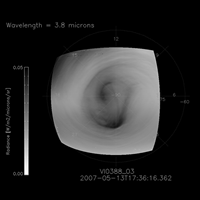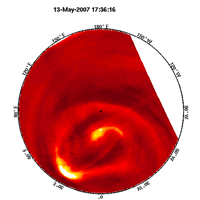Major Discoveries by Venus Express: 2006-2014
1. Shape-shifting polar vortices
Several planets in the Solar System, including Earth, have been found to possess hurricane-like vortices, where clouds and winds rotate rapidly around the poles. Some of these take on strange shapes, such as the hexagonal structure on Saturn, but none of them are as variable or unstable as the southern polar vortex on Venus.
The existence of the polar vortices on Venus has been known for many years, but high-resolution infrared measurements obtained by the Visible and Infrared Thermal Imaging Spectrometer (VIRTIS) instrument on Venus Express have revealed that the southern vortex is far more complex than previously believed.
 |
 |
| The southern polar vortex on Venus. (Click on the images for further details and full credits.) | |
The new observations show that the centre of the vortex has a highly variable shape and internal structure, and its morphology is constantly changing on timescales of less than 24 hours, as a result of differential rotation. This fast-moving feature is all the more surprising since its centre of rotation is offset from the geographical South Pole.
The images show that the core of the dynamic southern vortex can take almost any shape, so although it often looks like an 'S' or figure 8, it may become completely irregular, or even chaotic, in appearance. These rapid shape changes indicate complex weather patterns, which are strongly influenced by the fact that the centre of the vortex does not coincide with the geographical pole.
Images from the Venus Monitoring Camera and from the VIRTIS instrument show that the speeds of the zonal winds change with latitude, so that the vortex is continually being pulled and stretched. Although the mean zonal wind is retrograde (blowing from east to west), its speed decreases toward the pole.
The centre of rotation drifts right around the pole over a period of 5-10 Earth days. Its average displacement from the South Pole is about three degrees of latitude, or several hundred kilometres.
Although its highly elliptical orbit means that Venus Express flies too close to the planet's North Pole for detailed imaging, it is likely that both vortices have similar structures and behave in a similar way.
This is one of the major discoveries made by Venus Express during the last eight years. Read more on the following pages:
| Major discoveries by Venus Express: 2006-2014 |
|
#5. Snow on Venus? |
|
#6. Ozone layer |
|
#7. Water loss |


